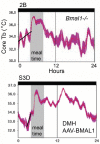Standards of evidence in chronobiology: critical review of a report that restoration of Bmal1 expression in the dorsomedial hypothalamus is sufficient to restore circadian food anticipatory rhythms in Bmal1-/- mice
- PMID: 19323828
- PMCID: PMC2670815
- DOI: 10.1186/1740-3391-7-3
Standards of evidence in chronobiology: critical review of a report that restoration of Bmal1 expression in the dorsomedial hypothalamus is sufficient to restore circadian food anticipatory rhythms in Bmal1-/- mice
Abstract
Daily feeding schedules generate food anticipatory rhythms of behavior and physiology that exhibit canonical properties of circadian clock control. The molecular mechanisms and location of food-entrainable circadian oscillators hypothesized to control food anticipatory rhythms are unknown. In 2008, Fuller et al reported that food-entrainable circadian rhythms are absent in mice bearing a null mutation of the circadian clock gene Bmal1 and that these rhythms can be rescued by virally-mediated restoration of Bmal1 expression in the dorsomedial nucleus of the hypothalamus (DMH) but not in the suprachiasmatic nucleus (site of the master light-entrainable circadian pacemaker). These results, taken together with controversial DMH lesion results published by the same laboratory, appear to establish the DMH as the site of a Bmal1-dependent circadian mechanism necessary and sufficient for food anticipatory rhythms. However, careful examination of the manuscript reveals numerous weaknesses in the evidence as presented. These problems are grouped as follows and elaborated in detail: 1. data management issues (apparent misalignments of plotted data), 2. failure of evidence to support the major conclusions, and 3. missing data and methodological details. The Fuller et al results are therefore considered inconclusive, and fail to clarify the role of either the DMH or Bmal1 in the expression of food-entrainable circadian rhythms in rodents.
Figures









Similar articles
-
The dorsomedial hypothalamic nucleus is not necessary for food-anticipatory circadian rhythms of behavior, temperature or clock gene expression in mice.Eur J Neurosci. 2009 Apr;29(7):1447-60. doi: 10.1111/j.1460-9568.2009.06697.x. Epub 2009 Mar 23. Eur J Neurosci. 2009. PMID: 19519629
-
Food anticipation in Bmal1-/- and AAV-Bmal1 rescued mice: a reply to Fuller et al.J Circadian Rhythms. 2009 Aug 10;7:11. doi: 10.1186/1740-3391-7-11. J Circadian Rhythms. 2009. PMID: 19664274 Free PMC article.
-
Persistence of a behavioral food-anticipatory circadian rhythm following dorsomedial hypothalamic ablation in rats.Am J Physiol Regul Integr Comp Physiol. 2006 Jun;290(6):R1527-34. doi: 10.1152/ajpregu.00874.2005. Epub 2006 Jan 19. Am J Physiol Regul Integr Comp Physiol. 2006. PMID: 16424080
-
Neurobiology of food anticipatory circadian rhythms.Physiol Behav. 2011 Sep 26;104(4):535-45. doi: 10.1016/j.physbeh.2011.04.015. Epub 2011 Apr 20. Physiol Behav. 2011. PMID: 21527266 Review.
-
Circadian adaptations to meal timing: neuroendocrine mechanisms.Front Neurosci. 2013 Oct 14;7:185. doi: 10.3389/fnins.2013.00185. Front Neurosci. 2013. PMID: 24133410 Free PMC article. Review.
Cited by
-
Stomach ghrelin-secreting cells as food-entrainable circadian clocks.Proc Natl Acad Sci U S A. 2009 Aug 11;106(32):13582-7. doi: 10.1073/pnas.0906426106. Epub 2009 Jul 24. Proc Natl Acad Sci U S A. 2009. PMID: 19633195 Free PMC article.
-
The role of melanocortin neuronal pathways in circadian biology: a new homeostatic output involving melanocortin-3 receptors?Obes Rev. 2009 Nov;10 Suppl 2(Suppl 2):14-24. doi: 10.1111/j.1467-789X.2009.00662.x. Obes Rev. 2009. PMID: 19849798 Free PMC article. Review.
-
Differential effects of light and feeding on circadian organization of peripheral clocks in a forebrain Bmal1 mutant.Elife. 2014 Dec 19;3:e04617. doi: 10.7554/eLife.04617. Elife. 2014. PMID: 25525750 Free PMC article.
-
Melanocortin-3 receptors and metabolic homeostasis.Prog Mol Biol Transl Sci. 2013;114:109-46. doi: 10.1016/B978-0-12-386933-3.00004-2. Prog Mol Biol Transl Sci. 2013. PMID: 23317784 Free PMC article. Review.
-
The neuroendocrine control of the circadian system: adolescent chronotype.Front Neuroendocrinol. 2012 Aug;33(3):211-29. doi: 10.1016/j.yfrne.2012.04.003. Epub 2012 May 23. Front Neuroendocrinol. 2012. PMID: 22634481 Free PMC article. Review.
References
-
- Boulos Z, Rosenwasser AM, Terman M. Feeding schedules and the circadian organization of behavior in the rat. Behav Brain Res. 1980;1:39–65. - PubMed
LinkOut - more resources
Full Text Sources

